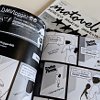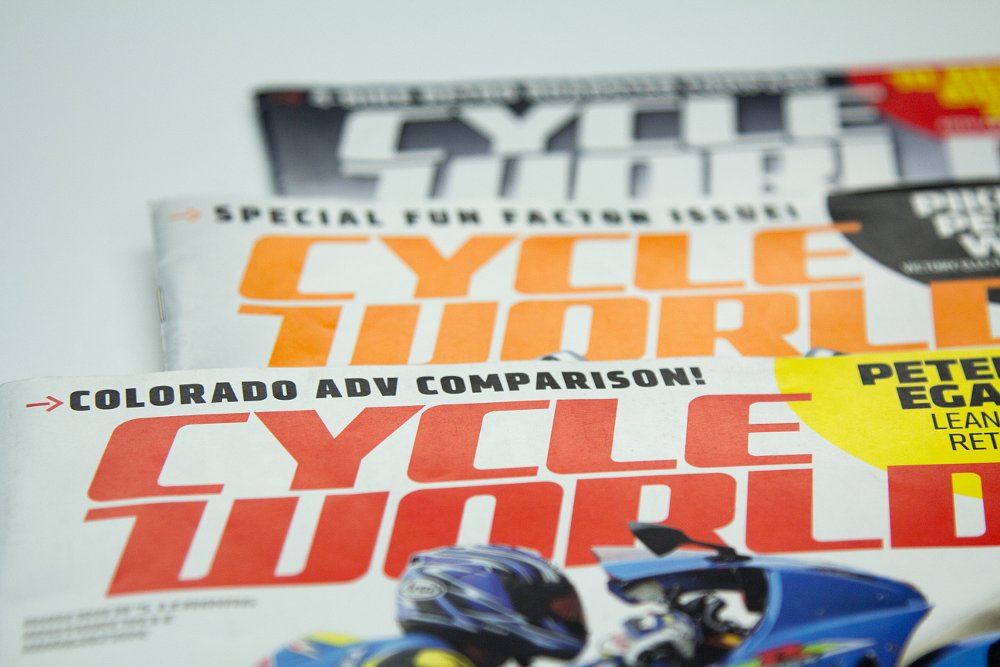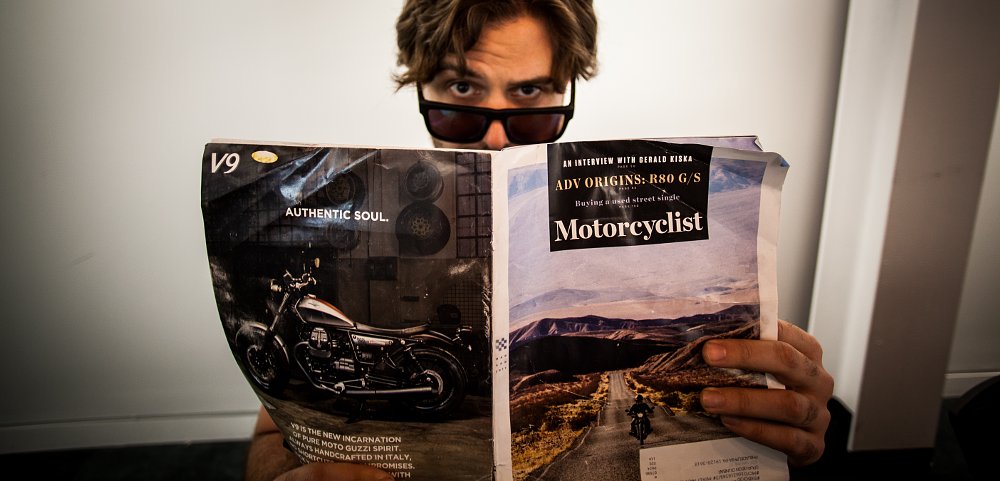We’ve watched motorcycle publications close up shop over the past few years, but many independent magazines are still going strong.
Some are regional publications that focus on local riding scenes. Others exist as a platform for artists and designers to showcase their work. But what they all share is a connection to their readers and the motorcycle community. Several of the editors and founders shared their insight into surviving as print publishers in a digital landscape.
Here are a few examples of print motorcycle magazines surviving in the digital age. Of course this is not a comprehensive list, so comment below with your favorite reads.

Motoveli
I expect to see a copy of Motoveli sticking out of the back pocket of a rider zipping through Midtown Manhattan. The petite eight-inch-by-five-inch booklet is a snapshot of the NYC riding life, full of stories, photo journals, comics, and something called "snack shootouts" from Ryan Snelson, the Rider-in-Chief, and other riders from the area.
Motoveli is “an experiment that’s evolving,” Ryan says. “There’s no advertising or sponsored content. Motoveli is bootstrapped and rider-supported. I make fake ads that spotlight behavior such as texting while driving, social media addiction, and cyclists getting hit by cars. I keep cost down by doing limited-edition runs with no reprints. What’s offline isn’t available online. When it’s gone, it’s gone.”
Snelson describes Motoveli as "abstract, a little artsy, and a bit philosophical. It’s a love letter about riding.” He says his core motivation for running Motoveli is that no matter where we live, as motorcyclists we’re a community.
“Big cities can feel lonely. People struggle with work, family, and addiction. People fight their way through moments on bikes by simply going for a ride and not dying," he says. "This is what I want to talk about.”
Motoveli both steps back from "all the insanity that happens online" while also embracing some of it. So if you want, you can add custom Motoveli filters to your Instagram helmet selfie or read comics in the zine to pass the time.
“Print should be a companion in the motorcycle content universe — not the only thing,” Snelson says.

DicE
Holding a copy of DicE magazine feels like you smuggled a piece of art out of the MoMA. If you can’t make it to The Congregation Show this year, a vintage and custom bike show produced by DicE, then get a copy and try not to drool on the bike pin-ups.
There’s no shortage of impressive paint jobs, close-ups of handmade details, and interviews with the builders. DicE editor Dean Micetich describes the magazine’s style as having, “wild layouts and cover designs that are always pushing the boundaries and controversial and unexpected.” With a full staff of riders, it’s easy to see that their investment in the subject drives the project.
“I think the main reason we are still publishing DicE is the passion we have for motorcycles," Micetich says. "How can you do anything related to DicE if you don't really understand it?”
Micetich and his team don’t play by traditional publishing rules. With no outside marketing and very limited ad space, DicE’s glossy pages aren’t full of distracting sales images.
"We're also extremely strict with who we let advertise in DicE," he says. "If it's a brand or product that doesn't fit, we won't allow it.”
You have to do a double take to realize the close-up of a rider’s foot on a kickstart is actually an ad for a boot company. Photos are given priority over text, which lets the bikes speak for themselves. This combination of innovative formatting mixed with old-school motorcycles reflects Dean’s attitude about the print industry as a whole.
“We genuinely don't care what other people think or what's 'hot in the motorcycle industry.' We publish a magazine that features bikes we love and think are cool. If you like DicE, great and if you don't, no problem.”
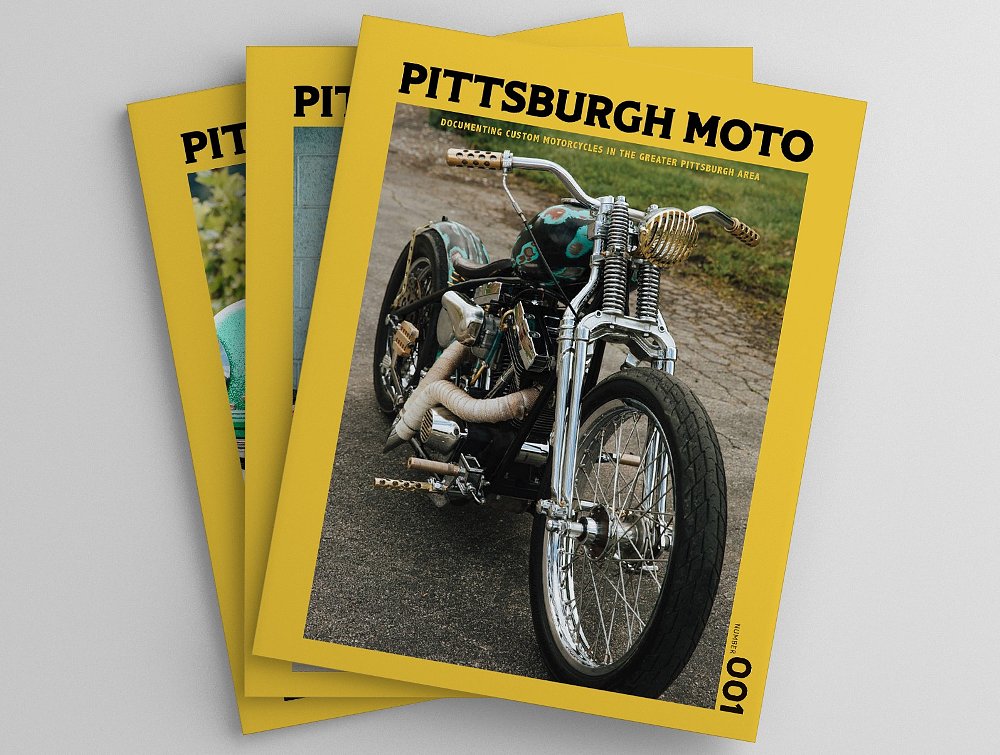
Pittsburgh Moto
"Quality" and "handcrafted" are perfect descriptions of Pittsburgh Moto magazine, with its collection of custom bikes from the Steel City. Builders there are in the business of sculpting steel into showstopping motorcycles that are featured at Glory Daze, a custom bike show in September that Pitt Moto sponsors and hosts. But if you can’t make it to the show, then subscribing to the magazine is like enjoying it from the comforts of your couch.
Editor Kurt Diserio and his wife, Alexa, created Pittsburgh Moto with the goal of growing the custom motorcycle scene in Pittsburgh. He explains that the publication is sustainable because they work on it in their free time while also working full-time jobs. Their recipe calls for “timeless content, great design, bold photos, few advertisements, and quality paper.”
He says they believe their involvement has contributed to “more young people getting involved, custom shops opening, and higher turnouts at events. Sometimes all it takes is a clever platform that showcases local talent and these fascinating two-wheeled machines.”

I asked if they think there is a link between motorcyclists and the desire to have pages to flip rather than a screen to scroll.
“I suppose motorcyclists enjoy the artistry of print and being able to hold something in their hands," says Kurt Diserio. "The construction and design mean a lot to those who take a hands-on approach to life. Similar to a well built bike, it's something that they can appreciate.”

Gnarly Magazine
Fans of the hot rod culture born out of the 1960s will love the Kustom Kulture art in the quarterly Gnarly Magazine. Every inch of the glossy pages features bike builds, painters, pinstripers, tattoo artists, metal workers, and every medium in between. Off-the-wall photo spreads are interspersed with artist interviews and history about Kustom Kulture.
Johnny VonGnarly, the editor, founder, and publisher of Gnarly, got his start Xeroxing copies of a skateboard fanzine and dreamed of having his own magazine. Managing a print publication takes around-the-clock commitment.
“You have to be prepared to eat, drink, sleep, and shit your publication,” he says.
“The Internet has killed off a lot of magazines and newspapers, sure," he says. "Remember, when the Internet blew up in the 90s, magazines and newspapers were just giving their content away for free in the hopes of driving people to their brand new website so they could make money off of banner ads.” Use of ad blockers, shifts in advertising and other changes since then have left big publishers scrambling to survive. Gnarly relies on a mix of advertising and merchandise sales to keep the print version going.
“It would be great if Gnarly Magazine could be ad-free, but without the support of our advertisers, it would be a real struggle to consistently publish issues.” But he points out that print magazines are still saved, while nobody is collecting printed blog posts.

Backroads
Named for the best kind of roads, Backroads Motorcycle Tour Magazine is a compilation of road-trip stories swapped between riders at a gas station, without the smell of hot, sweaty gear. Articles that highlight the best Northeast ice cream shops and quirky B&Bs are surrounded by advertisements for diners and dealerships. Brian Rathjen and Shira Kamil have been running the regional publication for 25 years and have watched the motorcycle market ebb and flow, but their main goal has always been “getting riders out on the road.”
“Someone gets into motorcycling, buys a motorcycle, and then might not know exactly where to go or what to do with said motorcycle," says Kamil. "Backroads steps in and gives them options and suggestions to form their own adventures.”
Riders both new and experienced are always looking for new roads to explore or the best barbeque in the tri-state area. I found inspiration to tour Pennsylvania’s dairy farms last year from one of their articles.
If you don't have a copy of Backroads with you, you can pick up a copy at many dealerships or garages and you can find the past 10 years of issues online. Rathjen says he has always believed that print and online media can and should co-exist.
“I know that if I read (in print) about a destination, motorcycles, person, place or thing that piques my interest I will follow that up with a web search. I believe that everybody does this.”
In the online version of the magazine, ads are linked to advertisers' websites so readers can immediately access the information they need. In addition to this creative marriage of digital and print, there's another reason Rathjen is not worried about print becoming obsolete.
“When finished, you can roll up Backroads and it will burn like a Dura-Flame log," he notes. "Try that with your iPad!”

META
Having META on your coffee table is proof that you’re a rider with impeccable taste in aesthetics. But don’t judge a book by its contemporary landscape orientation, because each volume of META is crafted with evergreen stories that blur the lines between the many genres of motorcycle culture. Adventures of riding off-road in Bali and photo journals of camping in Alaska have never looked more elegant than on crisp, matte pages.
“We are a small, independent publishing group that took this on as a passion project,” says Andrew Campo from META, which was launched more than six years ago. “We are motorcyclists first and publishers second.”
Andrew and his team manage all production and marketing in-house and have contributors from around the world.
"We are limited with ad space and that allows us the opportunity to work closer with our advertising partners,” Campo says. Advertisers are encouraged to focus on the brand, rather than the product, to match the publication.
“The experience of riding is something that takes you away from a digital landscape and it stands to reason our community would crave a more tangible experience to consume stories about their passion and lifestyle,” says Campo, talking about the tie between motorcycling and print. But META’s website supports the print publication with curated photos, videos, and news articles.
“I don’t believe that print is dying," he says. "I do believe that it is evolving and that the internet is a great tool to help build brand awareness, reach, and community. It’s all about balance.”
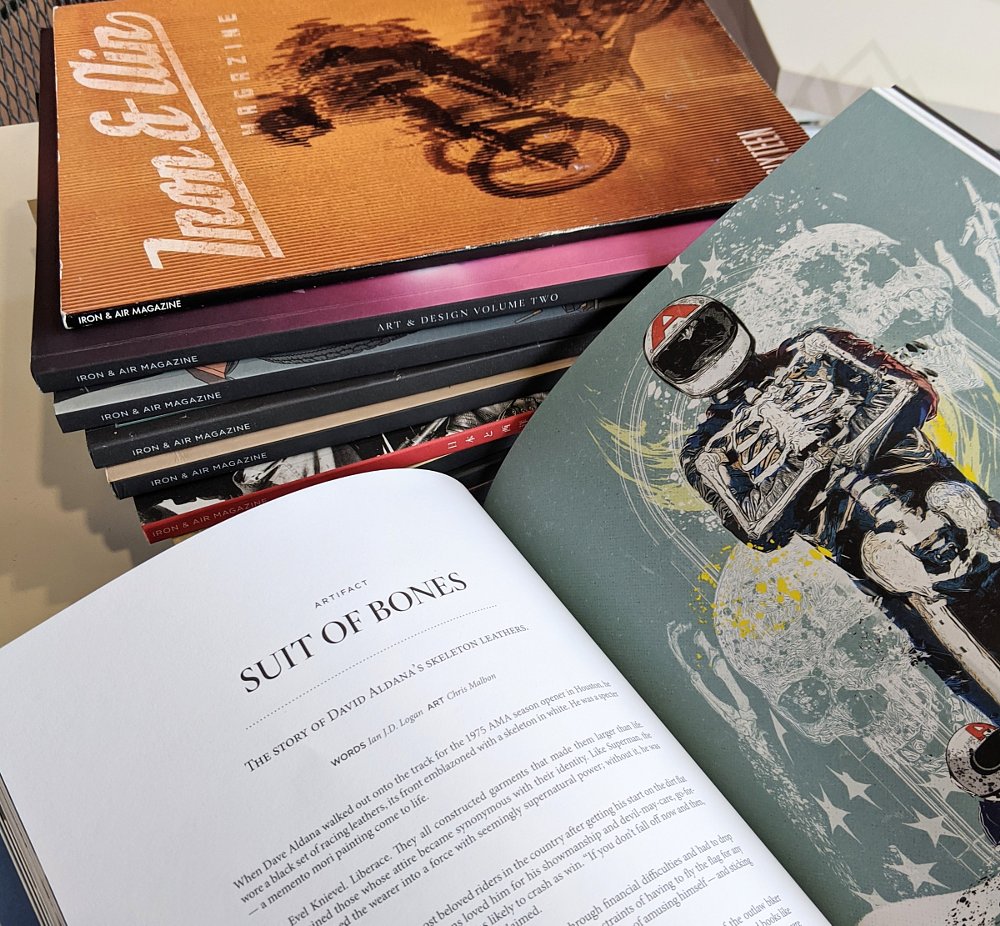
Iron & Air
When a group of people with different hobbies and interests get together, you get an impactful magazine and brand such as Iron & Air Media. Editor-in-Chief Adam Fitzgerald boasts that “the greatest compliment, however — and one we get a lot — is when someone tells us how much they love reading the magazine and they don’t even own a motorcycle. To know that we have created something that appeals to such a broad audience is really rewarding.” Each issue of Iron & Air is a collection of vintage bikes and cars, artists and storytellers. Branching out to include content beyond motorcycles is one of the ways Adam and his team are adaptable with the relationship between print and digital media.
“Print advertising is certainly one revenue stream, but several years ago, we made an internal shift with Iron & Air to stop calling ourselves a magazine, or a publisher,” says Fitzgerald. The print magazine is just one of the products the team creates. That change in perspective, he says, opened doors to allow all sorts of creativity, including not just storytelling and photography, but also video, apparel design, and more.
This flexibility and ability to adapt to the changing horizons of the motorcycle world is what sets Iron & Air and all these other publications apart. Just as there's room for both the constantly advancing technology in motorcycles today and the simplicity of our beloved vintage bikes of old, we can appreciate how both print and digital media bring us the stories we love.





